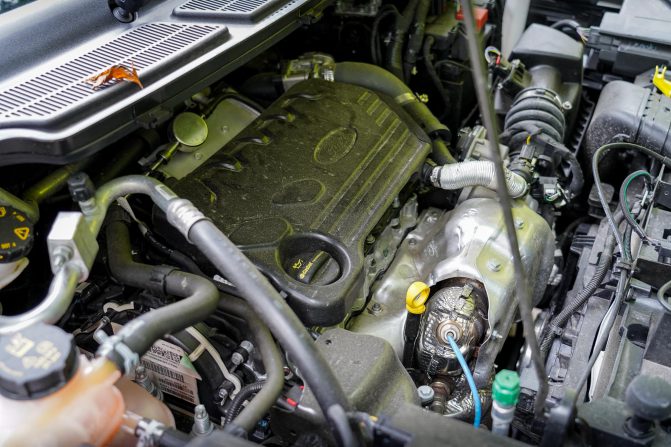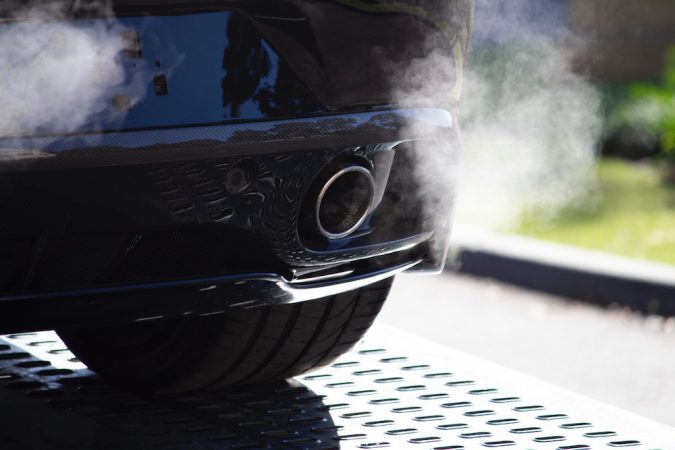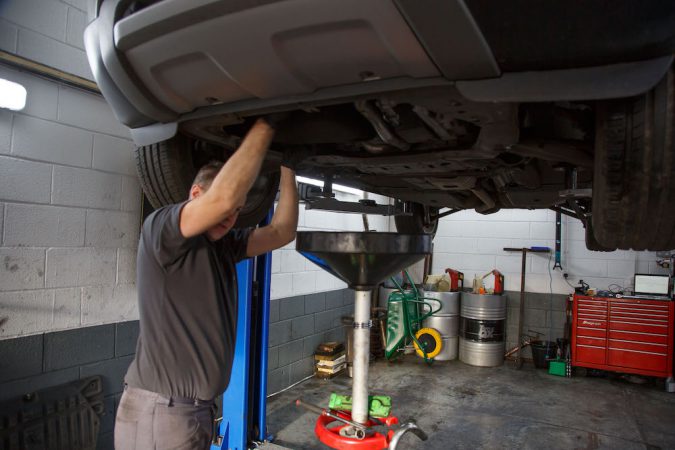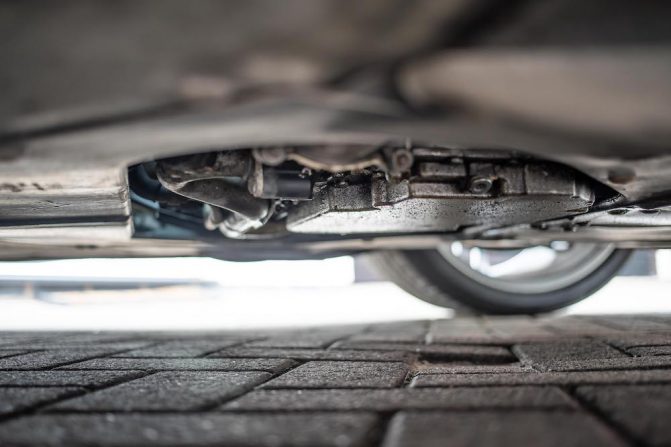Seeing fluid leaking from your car is worrying, to say the least. Especially if it’s colored fluid, as it’s probably crucial to the car’s operation. Do you have red fluid leaking from your car? There are three components that you will need to check and don’t worry, we’ll discuss all of them in this post.
We’ll discuss where the red fluid leaking from your car is coming from, what you will need to do about it, and other fluid colors that you will need to look out for in the future.
Red Fluid Leaking From Car: Engine Coolant
There are several possible causes for red fluid from your car. So, we’ll take a look at the possible causes, and eliminate them one by one until you find the cause. We’ll start with your engine coolant.
Engine coolant mainly comes in two colors: red and green. They’re largely similar, but red coolant has better antifreeze properties that last longer. This means if you live in a colder area, your manufacturer is likely to recommend you to use a red coolant instead of the green one, to prevent the coolant from freezing during those freezing winter days.
Coolant is bright red and they’re not very thick, they have about the same viscosity as milk. So, if the fluid leaking under your car fits this description, you’re likely looking at a coolant leak. Still not sure? Here’s how to diagnose them further:
Diagnosing Engine Coolant Leak
First, let’s make sure your car actually uses red coolant. This is simple enough, here’s how to do it:
- If you’ve been driving, wait for about 30 minutes for your engine to cool down. Checking the coolant while the engine is hot is very dangerous and can result in burn injuries.
- Open the hood.
- Locate either the radiator cap or the reservoir/expansion tank.
- Open the cap, and inspect the fluid inside.
If you have red coolant, then it’s likely you have a coolant leak – especially if the coolant is below the minimum level in the reservoir tank. If you have green coolant (or green antifreeze), then your leak is coming from somewhere else, in which case, you can ignore this and move on to the next segment.

But what if it turns out that your reservoir tank and radiator are empty and you don’t see fluid inside them? Well, this is confirmation you have a coolant leak. The car’s cooling system is a closed-loop system, meaning that the fluid is supposed to recirculate and they shouldn’t escape. If the radiator or tank is empty, this means you have a leak that causes you to lose coolant rapidly to the point where it’s depleted.
If this is the case, you’ll notice that your engine temperature gauge will rise above normal when you’re driving. In this case, we recommend finding the leak as soon as possible and fixing it. This is because driving an overheating engine will damage its internal parts, leading to an expensive engine rebuild.
How Do I Find The Leak?
Now that you know the red fluid is coolant, this means there’s a leak in the cooling system and you will need to find that leak. Here’s how to do that:
- Have a cooling system pressure tester on hand. They cost about $50 to purchase, but you can rent them from large auto shops such as AutoZone. Make sure that you get the correct adaptor for your car, as this may be necessary.
- If your coolant is depleted, refill the system first with a gallon of coolant. Make sure you do this procedure when the engine is cold.
- Determine whether your car has a pressurized radiator cap or a pressurized reservoir/expansion tank. This is where you will need to do the test.
- Remove the pressurized cap, and inspect the pressure amount that’s stated underneath the cap. Afterward, attach the pressure tester.
- Pump the pressure tester until it reaches the same pressure value that was stated on the cap. If you can’t reach that value, or it drops after you reach it, this means you have a leak.
- Inspect your engine bay, and see where the leak is coming from. If you have difficulty finding it, check underneath your car. If you see fluid leaking, check above it and see where it might be coming from.
Coolant leaks can be minor, and sometimes all you need to do is tighten a hose connection and its clamps. However, if the leaks seem to be coming from a crack in the hose, then you’ll need to replace the hose. Coolant leaks may also come from the cooling system’s components, such as the water pump, radiator, and heater core amongst other components.
If this is the case, you’ll need to replace them. But what if you can’t see the engine coolant leaking?
I’m Not Seeing Any Leaks, What Do I Do?
If you can’t seem to find it, this means one of two things: either the leak is so minor that you can’t see it, and you’ll have to get a mechanic to diagnose it. Or it’s coming from somewhere else, in which case, jump to the next section. But if you can’t see a leak and yet your coolant is depleted, you might have a blown head gasket. That sounds bad, doesn’t it? Well, sorry to break it to you, but it is.
The head gasket is a seal that connects your engine block to the cylinder heads. Its job is to prevent engine oil and coolant from seeping into the cylinders, and so it will flow through the engine as intended. A blown head gasket is when the gasket cracks, which then allows oil and coolant to leak into the cylinders.

This results in coolant being burnt along with fuel, causing you to lose coolant fluid. When coolant is burnt in the engine it will result in thick white smoke. If you see this coming out from your exhaust, you have a blown head gasket. Other symptoms you will experience include difficulty starting the engine, engine misfires, and bubbles in the radiator.
If you don’t see these symptoms, you probably have a minor leak in the cooling system. So you’ll need to look more carefully or go to a trusted mechanic. We wrote a great article about head gasket replacement costs and you can learn more about it here.
Red Fluid Leaking From Car: Transmission Fluid
If it’s not the engine coolant, the next possible cause is leaking transmission fluid. Transmission fluid is usually red and is darker and thicker than an engine coolant. If the fluid you see leaking underneath your car fits this description, you likely have a transmission fluid leak. But how do you diagnose it? The easiest way would be to check the transmission fluid level:
- Cars have different methods in how to check the transmission fluid. Some cars require the engine to be warm, others require the engine to run. Check with your owner’s manual on the correct way to do this.
- Locate the transmission dipstick, it usually sits behind the engine with a red or black handle. The yellow one is the engine oil dipstick.
- Pull it out, wipe it clean, and then reinsert it all the way in.
- Pull the dipstick out again, and see the markers. There’s usually a maximum and minimum marker, or two dots on the dipstick. Ideally, the transmission fluid should be somewhere in between these markers, preferably closer to the maximum marker.
- If the fluid is at or below the minimum marker, you likely have a transmission fluid leak.
The video above is a great visual guide on how to diagnose and find transmission fluid leaks. Additionally, you might see the following symptoms:
Symptoms Of Low Transmission Fluid
If you need more confirmation that you have a transmission fluid leak, here are the symptoms you might experience while driving:
- Difficulty changing gears. If you’re in a manual, you will have difficulty engaging the gears. Meanwhile, in an automatic, you may find the transmission refusing to change gears. Such as when going from Park to Reverse. Or sometimes it won’t change up when driving.
- Lurching or sudden jerks in automatic transmissions. Keep in mind this is sometimes normal in certain types of dual-clutch transmissions, especially when you get going from a stand-still.
- Humming or clunking noises.
- A burning smell. The transmission fluid is there to lubricate the transmission and this also keeps the temperature at an optimum level. A lack of transmission fluid can cause it to overheat (which is what the “AT oil temp” light in a Subaru points to), resulting in a burning smell.
- Automatic transmissions may engage limp mode (for troubleshooting’s sake, it might help to learn how to bypass limp mode).
If you see any of these symptoms, do not ignore them! This means either the transmission fluid is low, or there’s a faulty component within the transmission. Ignoring these symptoms will cause further damage to the transmission, and rebuilding a transmission is monumentally expensive.
Red Fluid Leaking From Car: Power Steering Fluid
The last component in your car that uses a red fluid is the power steering. The power steering is a hydraulic system, where it uses pressurized fluid to multiply the steering force applied by the driver. This results in steering becoming a lot lighter and easier for the driver.
However, many cars nowadays use electronic power steering. Meaning it uses a set of gears that are powered by the car’s electricity to assist the driver when turning the wheel. If your car has electronic power steering, then you can rule this out and your red fluid leak stems from something else.

If your car has hydraulic power steering, there may be a leak in the system. And when there’s a leak, the system will lose fluid and this will result in the following symptoms:
- The steering wheel is harder to turn. This is because a hydraulic system needs the correct amount of fluid and pressure. With fewer fluids, the pressure will decrease and this results in less assistance when you turn the steering wheel.
- Excessive vibration or locking steering wheel. Although at high speeds, this problem is attributed to unbalanced wheels.
- Squealing or whining noises when you turn the wheel.
Diagnosing Power Steering Fluid Leak
If you have power steering problems, this means either the power steering fluid needs to be changed, or there is a leak, causing the system to lose fluid. Power steering fluid needs to be changed every 75,000 – 100,000 miles. If you’ve reached that mark and haven’t changed the fluid, then changing it might solve the issue. It costs around $125 to change it for most cars.
But if you suspect you have a power steering fluid, here’s how to diagnose it:
- Open the power steering reservoir and see if there are air bubbles. This is confirmation that there’s a leak, and the air is seeping into the system which isn’t great.
- Locate the power steering pump, and see if there’s moisture. If there is, the power steering pump may be faulty and you’ll need to replace it.
- Follow the power steering line and see if you can locate a leak.
- Locate the CV joint boot and remove it. There’s going to be a power steering seal for the rack and pinion assembly, and if it’s broken, you’ll see red fluid all over it and the CV joint boot.
Once you locate where the leak is coming from, you’ll need to replace the part. We’ll talk about this more in the repair cost section.
Red Fluid Leaking From Car: Brake Fluid
This one is less likely as brake fluid in most cars is transparent with a yellow tint, similar to cooking oil. But some brake fluids are red, so, you’ll need to verify the color of your car’s brake fluid. Simply locate the brake fluid reservoir for the master cylinder – this also sits in your engine bay – and inspect the color.
If the brake fluid is yellow, then the red fluid leaking under your car is coming from one of the three aforementioned things. You’ll have to look harder or have a professional mechanic help you troubleshoot the problem. If it’s red, then your car may be leaking brake fluid.
The braking system is also hydraulic, much like hydraulic power steering. When you press on the brake, the system will pump the brake fluid throughout the brake lines. And when it reaches the calipers, it will push the calipers to come into contact with the brake rotors, which slows the car down.
As mentioned, without the correct amount of fluid, the system won’t have pressure and it can’t operate normally. If your brake pedal feels squishy and the braking force feels less powerful than it usually is, you might have a leak in the system. Here’s how to troubleshoot it:
Troubleshoot Brake Fluid Leak
Brake fluids most commonly come from the brake lines. This is because brake lines in most cars are made from rubber, which is very durable, but they are prone to punctures from road debris. Especially if your car doesn’t have an under guard. Additionally, the rubber will harden over time which makes them stiffer. When they’re stiffer, they’re prone to cracking especially when they flex – which often happens.
To help the process, you’ll want to park your car on a level and clean surface where you can see where the leak is located. You can also park the car on top of a tarp, just like the video above. Afterward, start the car and pump the brakes. This will cause the fluid to travel through the lines, and it will seep out from the leak.
Once you locate the puddle of brake fluid, that’s an indication of where the brake fluid is leaking from. If the leak is in the middle of underneath the car, then you probably have a leaky brake line. If the fluid is coming from near the wheels, then you have worn brake components. It’s likely to be a caliper seal failure.
The leak may also come from the brake’s master cylinder itself. If this is the case, you’ll see a puddle of brake fluid on the front of your car and in the engine bay as well.
Red Fluid Leaking From Car: Repair Cost Estimates
At this point, you’ve probably figured out where the leak is coming from. Whatever the cause, you’re likely going to have to replace some parts to fix the leak. The cost varies greatly depending on where the leak is coming from, and here are the estimates:
Coolant Leak Repair Costs
Since there are tons of components in the cooling system, the cost will vary greatly depending on which part you’ll need to replace:
- The radiator is one of the most expensive parts to replace since it’s the heart of your cooling system. It will cost anywhere between $290 – $1,200 depending on your car’s make and model. The average cost is somewhere around $670 including labor.
- The water pump is also quite expensive, costing somewhere between $450 to $650 for most cars. Expect the average cost to be around $550 including labor.
- Hoses. If the leak is coming from one of the radiator hoses, then replacing it will cost you between $150 – $200 including labor. If the leak is small, you may be able to use a sealing compound to fix the problem. They’re cheap and easy to use, but this is only a temporary solution.
- The heater core is the heart of your car’s heating system. They cost somewhere around $560 – $930 to replace, but you can bypass the heater core for an easier and cheaper fix. Although you won’t have heating in your car afterward.
- Radiator or expansion tank cap, depending on which one in your car is pressurized. These pressurized caps can fail over time, and cause a leak when they do. They cost anywhere between $15 to $50 to replace depending on your car’s make and model.
Transmission Fluid Leak Repair Costs
Transmission fluid leak can come from several components in the system, and the cost will vary:

- The valve body is the component that controls the fluid supply for your transmission. If this is the source of the leak, expect to pay somewhere between $450 – $800 to replace them, including labor.
- The transmission solenoid is an electromechanical device that controls the flow of fluid by controlling the valves inside the valve body. They can go bad as well which will cause a transmission fluid leak. They cost around $15 – $150 to replace, and an extra $200 – $300 for the labor cost.
- Transmissions also have a pan to collect the fluid when not in use. The pan gasket may crack over time which can cause a leak, this will cost you somewhere between $100 – $350 to replace including labor.
- Last but not least, the transmission seals may also leak. Rear seals are easier to replace and costs around $250 – $400. However, the front seals are more difficult to replace as they will require your mechanic to essentially disconnect the transmission from the engine. This process is very labor-intensive and will cost somewhere between $400 to $1,000.
Power Steering Fluid Leak Repair Costs
Again, you’ll need to identify where the leak is coming from. Here are the parts you may need to replace if you have a power steering fluid leak:
- The power steering pump will cost somewhere around $500 – $700 to replace including labor.
- If you have a leak from the power steering lines, then it will cost around $400 – $500 to replace including labor.
- And if the leak comes from the power steering rack and pinion seals, this is the most expensive one to replace. Costing anywhere between $300 – $1,000 to replace, depending on your car’s make and model.
Brake Fluid Leak Repair Costs
- A master cylinder leak means you’ll have to replace this part. It will cost somewhere between $400 – $550 to replace the master cylinder, including labor.
- If the brake line is leaking, it will cost somewhere around $150 – $200 to replace. Learn more about brake lines in our article here.
- The brake calipers are potentially the most expensive to replace when it comes to a brake fluid leak. They cost between $550 – $700 to replace (including labor), but can easily be higher if you have high-performance brakes.
Can I Do These Repairs Myself?
With the exception of several parts, such as the radiator cap, bypassing the heater core, and replacing the radiator hoses, we don’t recommend you do these replacement jobs yourself. They require quite a lot of mechanical skill, as well as time to replace.
Replacing the radiator cap is as simple as removing the old one, and then installing a new one. Meanwhile, bypassing the heater core means disconnecting the hoses that connect to the heater core, and installing a new hose connector or coupler. You can read more on how to bypass a heater core here. And installing a new radiator hose is usually quite easy, although it’ll take a bit more time.
As for the rest, we recommend leaving it to the professionals and sucking up the labor cost. They’re a lot more difficult to do, and it’s easy to get it wrong, which can damage other parts in the process. Bottom line, unless you have the right tools and you know what you’re doing, we don’t recommend doing the repair jobs yourself.
Here are ten need-to-know facts about identifying car fluid leaks:
- A puddle of mysterious liquid underneath your car is usually a sign of a fluid leak.
- A car uses many fluids to function properly, and any of these fluids can leak from time to time.
- The color and texture of the fluid can help identify which fluid is leaking.
- Red fluid leaking from your car could be either automatic transmission fluid or power steering fluid.
- Light yellow fluid leaking from your car is probably brake fluid.
- Orange fluid leaking from your car could be coolant or automatic transmission fluid.
- Pink, yellow, or green fluid leaking from your car is most likely coolant.
- Blue fluid leaking from your car is most likely windshield washer fluid.
- Brown or black fluid leaking from your car is likely engine oil.
- Clear fluid leaking from your car could be either water or gasoline.
Red Fluid Leaking From Car: Wrap Up
To summarize, red fluid leaking from your car can come from one of four things: the cooling system, the transmission fluid, the power steering system, and – less likely – from the braking system. Wherever it comes from, we recommend diagnosing and fixing the problem as early as possible.
It’s never a good sign when your car is leaking fluid. And any of these issues can cause damage and excessive wear to parts in your car, leading to even more expensive repairs. In some cases, ignoring a fluid leak can compromise the safety of your car put you at significant risk when you drive.

